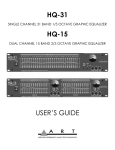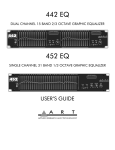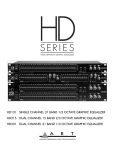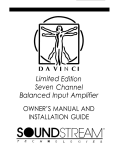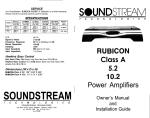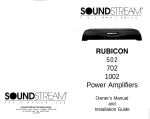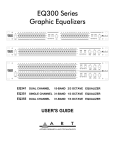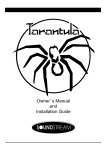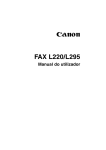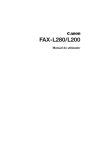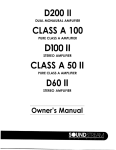Download Soundstream Technologies 501 Stereo Amplifier User Manual
Transcript
RUBICON 501/ Power Amplifier Owner’s Manual and Installation Guide 1 Congratulations! You now own the Soundstream RUBICON amplifier, the product of an uncompromising design and engineering philosophy. Your Soundstream RUBICON amplifier will outperform any other amplifier in the world. To maximize the performance of your system, we recommend that you thoroughly acquaint yourself with its capabilities and features. Please retain this manual and your sales receipt for future reference. Soundstream amplifiers are the result of American innovation and the highest quality control standards. When properly installed, they will provide you with many years of listening pleasure. Should your amplifier ever need service or replacement due to theft, please record the following information which will help protect your investment. Model and Serial # Dealer’s Name Date of Purchase Installation Shop Installation Date CAUTION! Prolonged listening at high levels may result in hearing loss. Even though your new Soundstream Rubicon amplifier sounds better than anything you’ve ever heard, exercise caution to prevent hearing damage. 2 Table of Contents Design Features ............................................................. p 4 - 5 Rubicon Amplifier Diagram ............................................. p 6 - 7 Crossover and Phase Adjustments ................................ p 8 Hawkins Bass Control™ Theory and Use ...................... p 9 - 10 Installation: Wiring, Diagram, and BIO Port .................... p 11 - 12 Installation: Mounting ..................................................... p 13 Installation: Level Setting and Front Spoiler .................... p 14 Protection Circuitry and Troubleshooting: ...................... p 15 Service and Specifications ............................................. p 16 3 DESIGN FEATURES ¨¨ SLA/SH™ ( Speaker Load Adapting / Subwoofer Hyper-Efficient) This new dual function technology currently operates in two different ways in different models. In subwoofer applications the power supply tracks the incoming audio signal and increases or decreases its own voltage level to mirror the input. This design results in enormous low impedance, low frequency stability and maximum efficiency, since no power is wasted maintaining an unnecessarily high voltage level in the power supply. ¨ BIO™ Port (Bridging In and Out) Enables two identical mono amplifers channels to be fused together into a single subwoofer load with double the output power. ¨ STACT™ (STabilized Apex Current Topology) Reduces power supply stress by 50%. Typical designs degrade the stereo image due to phase reversal of even-order harmonic distortion that occurs between the inverted channels. In the STACT design, inversion is done at the power amplifier drive stage. Since the fully symmetrical power amplifier produces no even-harmonic distortion itself and all preamplifier circuitry is run completely in-phase, no even harmonic distortion phase reversal occurs. ¨ Trident™ Protection Topology provides three types of protection: 1. Output protection against short circuits or improper loads. 2. Ground fault detection: Shuts down the amplifier when a significant voltage (> 5Volts) fluctuation occurs between electrical (turn-on lead) and battery ground. 3. Thermal Protection: Puts the amplifier into thermal rollback or shuts the amplifier down in extreme thermal conditions. ¨ Hawkins Bass Control - Fully adjustable subwoofer equalizaton circuit providing frequency and boost (“Q”) adjustment for optimum subwoofer performance. A frequency tracking subsonic filter protects woofers from potentially harmfull low frequency information and maximizes output in a usable range. ¨ Harmonic Bass Alignment™ The 2nd and 3rd order harmonic peaks are critically aligned to fundamental peaks at low frequencies. This produces tighter, more accurate bass reproduction. ¨ Drive Delay II™ Amplifier section powers up 2 to 3 seconds after the power supply eliminating turn-on and off pops. The turn off process is reversed: Amplifier section turns off first, followed by the power supply. 4 ¨ Output Clipping Indicator indicates clipping on the output stage of the amplifier. Monitoring the clipping indicators allows the user to achieve maximum Sound Pressure Level without clipping the amplifier. ¨ Dynamically Optimized Power Grid™ Power grid is evenly distributed between primary and secondary power supplies, providing greater dynamics and improved RF filtering. ¨ Chassisink™ All transistors are ideally located and sandwiched between the circuit board and the heatsink to provide cool efficient amplifier operation. ¨ Differentially Balanced RCA Input eliminates ground loop related noise in the audio. ¨ Continuously Variable Crossover Network: 24 dB/Octave lowpass crossover variable from 40 to 160 Hz. ¨ Flexible Input Level Control allows 200 mV to 5 V input sensitivity. ¨ Symmetrical Discrete Balanced Class A Drive Boards auto-adjust for linear performance while driving low impedance loads. ¨ Removable Front Spoiler allows for stealth installation of RCA, Balanced Line, Speaker and Power wiring. 5 FUSES 1 SOUNDSTREAM GND - + f-----l REMOTE 2 +12v LP XaOVER dB HAWKINS 1 FREQ BOOST r l SUB _ HAWKINS BASS CONTROL SONIC Iv LEVEL PHASE 00~1800 i 1 INPUT 0 Sol/ IN 810 PORT -R 0 I I +l CUP KEY TO CALLOUTS 1. 2. 3. 4. 5. 6. 7. 8. 9. 10. 11. 12. 13. 14. 15. Power LED - Indicates amplifier power, either in High Power or Auto High Current. Clip Indicators - Indicates the signal output level is too high and the output stage of the amplifier is clipping. Phase Selector - Select between 0 or 180 degrees of output on speaker terminals. Subsonic/Hawkins Bass Control Switch - Selectable subwoofer enhancement circuit. Select “SUB SONIC” to engage the Sub Sonic filter with no boost. Use the knob indicated by callout #9 to set the frequency: 1330Hz. Select “Hawkins Bass Control” to engage the Sub Sonic filter with available boost. Use the knob indicated by callout #9 to set the frequency: 30 Hz to 70 Hz. BIO Port - RCA input and output connections for bridging two identical amplifiers. In BIO mode connect between the master amplifier’s 501/OUT to the slave amplifier’s 501/IN. This will bridge the amplifiers and bypass the preamplifier controls on the slave amplifier. RCA Inputs - Right and Left channel RCA inputs. Input Level - Input level control variable from 200 mV to 5 V. Hawkins Bass Control “Boost” Adjustment - Varies from 0 to +9 dB of boost when the Hawkins Bass Control circuit is engaged. Subsonic/Hawkins Bass Control Adjustment - Frequency adjustment control for the Hawkins Bass Control filter or the Sub Sonic filter. Low Pass Filter Control Adjustment - Frequency adjustment control for the Low Pass filter. Speaker Connection Terminal - Speaker connections for mono channel. REMOTE - Remote turn-on input from the head unit. Accepts +12V. GND - Main ground connection. Bolt to a clean chassis point in the vehicle. +12V - Connected to a fuse or circuit breaker, then to the battery’s positive terminal. FUSE - Main power supply fuse. Warning: Replace only with the same value fuses! 7 CROSSOVER & PHASE ADJUSTMENTS The RUBICON amplifiers incorporate an on-board staggered electronic crossover. No external electronic crossover is necessary. The low pass portion of the crossover can be set independently of the rest of the system. In many car audio installations, there is a tendency for a “midbass boom.” Because of their interior dimensions, most cars will resonate or ring at these midbass frequencies. If we design the system so there is reduced output in this region, the final response is very smooth and natural sounding. The Rubicon501/ has an always on low pass crossover that is independently variable from 40 to 160 Hz at 24 dB/Octave. For initial crossover setup, try setting the low pass filter to approximately 60 Hz, and the high pass filter on the rest of the sytem 12 dB/Octave High Pass to approximately 100 Hz. Change the crossover points to accom24 dB/Octave Low Pass modate a good mixture of frequency response, power handling, and personal preference. Phase Switch In many car audio systems placement of the subwoofers can cause them to be out of phase with the rest of the system. This may cause poor subwoofer performance due to varying arrival times. To eliminate this the Rubicon501/ incorporates a 0 to 180 phase switch. By playing low frequency music and experimenting with the subwoofer phasing better sound quality and bass imaging may be obtained. 8 Hawkins Bass Control - Theory and Use SUB . HAWKINS SONIC BASS CONTROL PHASE CP*1800 HAWKINS 1 FREQ BOOST r X*OVER LP HZ HAWKINS 30-70 Hz 4 SUBSONIC 1 J-30 Hz Hawkins Bass Control (parametric) is a unique subwoofer control circuit included with the Soundstream RUBICON501/ amplifier. It is capable of removing subsonic energy in program material while boosting subwoofer frequencies. The circuit consists of two controls. One adjusts the frequency of operation and the other adjusts the range of boost. With both controls adjusted fully counter-clockwise, no boost is applied and the amplifier is flat in response down to 20 Hz. FIG.BASS CONTROL quency control (Hz) adjusts the 5 starting point of the subsonic filter. o On the RUBICON501/ the high pass dB -5 filter has two frequency ranges. When the bass control switch is set to “SUB SONIC”, the high pass filter frequency can be adjusted from 13 Hz up to a maximum of 30 Hz. In ,. this setting, no boost “Q” control is available. This control is useful for 5 0 setting the lowest frequency that your subwoofer will see (see figure 1). dB 3 When the bass control switch is set 1:: to “HAWKINS BASS CONTROL”, the -20 high pass filter frequency can be ad- -25 justed from 30 Hz to a maximum of -301 70 Hz. In this setting, there is an available boost control of 0 to +9 dB. FIG. 2 VARIABLE “Q” FIG. 3 VARIABLE HIGH PASS The Boost control adjusts the amount of level applied at the set frequency. This is adjustable from flat (OdB) to +9 dB. (See figure 2) -5 dB -10 FIG. 4 VARIABLE BOOST When the Boost is set to 0, Hawkins acts as a sub-sonic filter only. (See figure 3) The simple act of removing potentially harmful low frequencies can improve system output by as much as 3 dB. (see figure 4) 9 Application Subwoofer drivers in general have excellent power handling characteristics over their operational bandwidth. This bandwidth is determined by many factors, including driver design, and enclosure type. It is possible to overdrive any subwoofer FIG. 5 LIMITED EXCURSION driver by sending powerful signals outside of its operational bandwidth. These potentially damaging signals can be removed by adding a subsonic filter. Figure 5 shows the effectiveness of the Hawkins Bass Control on woofer excursion in a vented enclosure. The woofer travels 7.5 mm at 10 Hz. With Hawkins Bass Control properly adjusted, this excursion can be reduced to less than 1 mm. This is of great benefit to lowering woofer distortion and increasing output. Adjustment An easy method of optimizing your existing subwoofer enclosure with Hawkin’s “Hz” control is as follows. 1. Adjust frequency and boost control to full CCW position. 2. Set the bass control switch to “HAWKINS BASS CONTROL”. 3. While listening to music with strong bass content at a moderate level, slowly adjust frequency control clockwise. Listen for a reduction of bass response. Now, rotate frequency control slightly backwards. This serves the purpose of removing the “subsonic” bass energy. With Soundstream’s Hawkins Bass Control, the boost and frequency control can provide virtually any combination of boost and cut to suit your designs. So, Hawkins Bass Control can provide the “tailoring” needed for any type of “assisted” design and any woofer in any type of installation. FIG. 6 VARIOUS SETTINGS 10 ( INSTALLATION STEP 1 WIRING POWER AND GROUND To ensure maximum output from your RUBICON amplifier, use high quality, lowloss power and ground cables and connections. The RUBICON amplifiers will accept up to 4 gauge power and ground cables. Determine from the chart below the minimum gauge power and ground wire for your application. up to 70’ RUB/CON 507/ 1 up to 20’ 4 or 8 gauge I 4 gauge only CIRCUIT BREAKERS AND FUSES EXTERNAL Like all audio components, the RUBICON amplifiers must be fused near the batters. A fuse or circuit breaker must be located within 18” of the batterv. This will prevent a fire in the event of a shorted cable. See the chart below to determine the correct fuse value. e * INTERNAL The RUBICON amplifiers are fused with an automotive-type or Maxi-fuse. In the event of a blown power supply fuse(s), replace with the correct value fuse found in the chart below. Never replace the fuse with a higher value than what is supplied. This may result in amplifier damage and will void the warranty! RUB/CON Amplifier Fuse Values Battery Fuse / Circuit Breaker Amplifier Fuse 1 RUB/CON 507/ 1 (2) 30 amp automotive 11 I 80 amp I REMOTE TURN-ON Connect the “Remote” line to the turn-on lead from the source unit. When +I2 Volts is received, the amplifier will turn on. SIGNAL CABLE Use a high quality cable that will be easy to install and has minimal signal loss to guarantee optimum performance. SPEAKER CABLE The RUBICON amplifiers will accept up to 8 gauge speaker cable. Use a high quality, flexible, multi-strand cable for best performance and longevity. SAMPLE WIRING DIAGRAM rI 1 FUSES +12v GND REMOTE - + X-OVER r HAwKlNs FREQ 1 BOOST LEVEL INPUT 1 1110 PORT To Chmds TO+lfB ToRemde I Turn-on , f- 1 Head Unit 1 r B/O Port Bridging Option The RubiconSOl/ amplifier has the ability to be bridged to another identical amplifier for double the output by using the BIO Port. When this feature is used, the master amplifier’s level and crossover switches affect both amplifiers (the slave amplifier’s controls are totally bypassed). By switching the phase switch to 180 on the slave amplifier and connecting a RCA cable from the 501/ OUT on the master amplifier to the 5011lN on the slave amplifier both amplifiers are synchronized. Then connect a positive speaker cable to the master amplifier’s positive speaker terminal and the other speaker cable to the slave i n a l l terminal. y c o n n e c t t h e s p e a k e r wires to a single load amplifier’s F positive no less than 2 ohms. This will supply twice the power of a single amplifier. 12 INSTALLATION STEP 2 INSTALLATION AND MOUNTING AMPLIFIER LOCATION The RUBICON amplifiers employ highly efficient circuitry, a custom-engineered heat sink, and a unique Chassisink construction to maintain lower operating temperatures. Additional cooling may be required if the amplifier is located in a tightly confined area or when driving especially low impedance loads at extremely high levels. When mounting the amplifier, it should be securely mounted to either a panel in the vehicle or an amp board or rack that is securely mounted to the vehicle. The mounting location should be either in the passenger compartment or in the trunk of the vehicle, away from moisture, stray or moving objects, and major electrical components. To provide adequate ventilation, mount the amplifier so that there are at least two inches of freely circulating air above and to the sides of it. MOUNTING THE AMPLIFIER a. b. c. Using the amplifier as a template, mark the holes on the mounting surface. Remove the amplifier and drill the holes for the mounting screws. Secure the amplifier to the mounting surface using the supplied hardware. WIRING a. b. c. d. e. f. Run and connect the audio signal and remote turn-on cables to the amplifier from the source unit. Carefully run the positive cable from the amplifier to a fuse or circuit breaker within 18” of the battery. Connect the fuse or circuit breaker lead to the battery. Leave the circuit breaker off or the fuse out until everything is bolted down. Secure the ground cable to a solid chassis ground on the vehicle. It may be necessary to sand paint down to raw metal for a good connection. Double check each and every connection! Re-connect the fuse or circuit breaker. POWER UP Power up the system, there may be a 2-3 second delay from the time the source unit is turned on to the time that the amplifier turns on, which is normal. Once the amplifier LED is on and the source unit is playing, you should have sound coming from the speakers. 13 INSTALLATION STEP 3 LEVEL SETTING The input level is adjusted by means of the input level control located on the front of the amplifier. This is a unique dual-stage circuit that adjusts both level and gain. This topology maintains better S/N Ratio even when using sources with minimal output. In the ideal situation, all components in the audio system reach maximum undistorted output at the same time. If you send a distorted signal to an amplifier, it is simply going to amplify distorted information. The same holds true if an outboard processor or crossover begins to distort before you have maximum output from the amplifier. By setting all components to reach clipping at the same time, you can maximize the output of your system. For the RUBICON amplifiers, follow these steps for setting the input levels: 1. 2. 3. Turn the amplifier’s input levels to minimum position (counter-clockwise). Set the source unit volume to approximately 3/4 of full volume. While playing dynamic source material, slowly increase the amplifier’s input level until a near maximum undistorted level is heard in the system. The clipping indicators on the top of the amplifier let you know when the output of the amplifier is reaching its maximum level, and has begun to clip. FRONT SPOILER Once the amplifier is installed and the proper levels set, place the front spoiler in position, and secure it on using the supplied hardware. 14 TRIDENT PROTECTION CIRCUITRY Your Rubicon amplifier is protected against both overheating and short circuits by means of main power fuses and the following circuits: + Speaker Output Protection + Ground Fault Differential + Smart Power Supply Thermal Rollback & a Thermal Protection Circuit NOTE: If you experience blown main power supply fuses, if is like$ that the amplifier is seeing a dead short, either in the speaker wire or in the speaker itself. Rectify the problem before b/owing mu/tip/e fuses! DO NOT increase values beyond the original fuse value! Doing so will void your warrant and may damage your amplifer. TROUBLESHOOTING CAUSE PROBLEM No Sound and power LED is not lit 1. No power or ground at the amp. 2. No remote turn-on signal 3. Blown fuse near the battery No sound, power LED is lit. 1. No signal input 2. The AIRBASSkcessory switch is in the “IN” position. Move it to the “OUT’ position. Repeatedly blow amp fuse; frequent activation of Smart Power Supply Circuit 1. Speaker or leads may be shorted 2. Verify adequate amp ventilation “Clip” indicator lighting Output signal level is too high and the amplifier output is clipping. Reduce the level either at the source or at the input level controls. 15 SERVICE Your Soundstream RUBICON amplifier is protected by a limited warranty. Please read the enclosed warranty card for details. SPECIFICATIONS 1 SZMono 4SZMono 2MMono (4 CI BIO Bridged) (2 a BIO Bridged) (1 C2 BIO Bridged) (12.6 Vdc) (14.4 Vdc) (14.4 Vdc) POWER I 5011 I 2ooWxl (800W x 1) THD Signal to Noise Frequency Response Damping Input Sensitivity Input Impedance 4oow x 1 5oow x 1 (1ooowx1) W) Maximum Rated Output 500 wtts co. 1% >90 dB 20 Hz k 0.5 dB to 160 Hz 2 3 dB >200 200 mV to 5.0 Volts 10k Ohms Crossover Specifications Low Pass: 40 Hz - 160 Hz at 24 dB/Octave Hawkins Bass Control Sub Sonic Filter: No boost, High Pass filter from 13 to 30 Hz. Hawkins Bass Control: 0 to +9 dB Boost; Boost and Sub Sonic filter, variable from 30 to 70 Hz. Dimensions (W x D x H) RUBICON50lI: 8.5” X 9.8” X 2.25” SOUNDSTREAM” 1 E C H N L 0 0 G I SOUNDSTREAM TECHNOLOGIES 11365 Sunrise Park Dr - Ranch0 Cordova - California 95742 USA ph 916.351 .I288 - fax 916.351.0414 rev A - 9/2MXl 16 E S

















